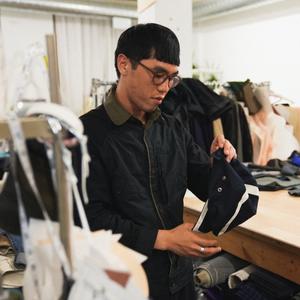“I feel like up-cycling is almost becoming a buzzword, not as an ethos but as an aesthetic. I think the way that I [up-cycle] now is a response to how I used to do it, or how people still up-cycle. I feel like what’s currently on the market that’s described as up-cycling is actually down-cycling, or recycling at best. To up-cycle something you need to put less energy into the thing that you’re making than the thing it originally came from took to make it. Or use less resources, or use something nearing the end of its life cycle. — Is transforming an existing garment the best way of getting a desired end result, or can you do it another way that is going to take less energy, look just as good, tell another story?"

“I was not a kid that had an allowance. I started working at shoppers drug mart when I was 14. My mom taught me about quality fabrics and sewing. She was a seamstress that made high-end custom suits and dresses back in Russia. So, I played around with refashioning from the beginning because I didn’t have money to go and buy the clothes I wanted. And you’re standing out because of it, so you kind of have to step up and have an idea of what you’re going to say when someone asks ‘What the hell are you wearing?’ It made me feel okay with being an outsider.”

“In our The Caricature of He (2019) collection — There was a piece that we called the Lumber Pearl Jacket. It was my take on an outdoorsy jacket, like what a caricature of a lumberjack would wear, through American cartoons and Americana in general. I decided for that piece, when I was designing it, that men are so fragile. We sort of changed the panelling of it, and I added pearl buttons throughout the piece. I felt like people had a certain perception of who can wear pearls. As well, I was considering my perception of who I saw wearing pearls when I was growing up. It broke down manliness through my eyes.”
